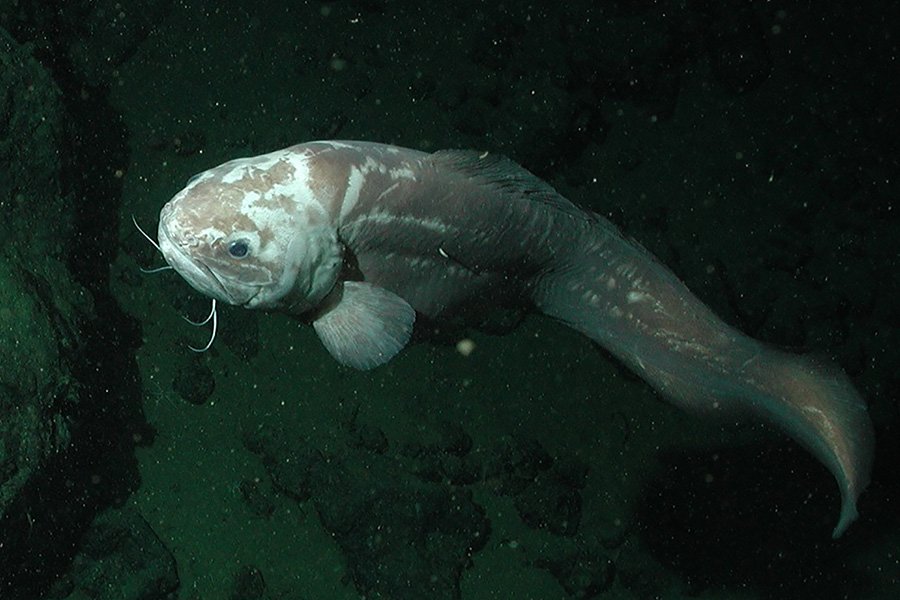Fishing in Baxter
by Kyle McNally
Baxter State Park has more than 50 ponds and lakes which makes it perfect for a wide variety of remote, rare, and fun fishing opportunities. Most bodies of water can be fished and you can find several different species in different locations. Some of the most sought-after fish you might find are brook trout, salmon, arctic char, lake trout, and cusk but that’s not all there is to offer.
Brook Trout
The brook trout is one of the most sought-after fish, not only in Baxter but all of northern Maine. Brook trout are also the most common fish to find in Baxter and can be found in most bodies of water throughout the park which is what makes these fishing spots so special. These fish are quite resilient to natural habitats, but because of illegal introductions of other species of fish like bass and perch it can make it almost impossible for these native fish to survive. Luckily for the brook trout, the park's rules and laws keep these invasive fish out in order for the native fish safe and able to thrive.
Brook trout or brookies are coldwater fish that are typically found in water ranging from 50-65 degrees (this can vary). The water should also be well oxygenated and clean. 3-year-old brook trout range from 7.5-17.5 inches and they average 13.3 inches but this all can vary greatly depending on many factors. Most anglers use a 4 lb test line or less considering a 4 lb brook trout is huge by anyone's standards.
If you're fishing in the spring it's most effective to fish near shore using small dry flies, streamers, copper lures, and worms. In the summer months, it's more likely to catch them at depths of 10-35 feet. Small streamer flies, nymphs, copper lures, or worms are known to work best along with techniques like spin casting, fly fishing, and trolling.
Identifying the fish can be difficult because of similar species like arctic char and because their color varies depending on habitat but you should look for dark wavy worm-like lines on their back. You should also see white leading edges on their fins including their tail. The tail should also be square.
Artic Char
The arctic char is very similar to the brook trout in many ways, but they are extremely rare. They are the northern-most fish in the world and are usually found in certain parts of Canada and Nordic countries which is what makes having them in this park very special.
Similar to brook trout, arctic char are coldwater fish, but char prefer water colder than 55 degrees and will tolerate warmer temperatures if there are feeding opportunities. These fish can live up to 15 years and grow up to 3 lbs but this is rare. Your average char is about 6 inches and only a few ounces. A 2 lb char is of significant size. Most of these conditions are dependent on the environment like their food source and the altitude of the pond they’re in.
Char are considered predators and can grab prey from the surface of the water and be taken to the bottom of the lake Smaller fish are also sometimes eaten. Their diet is adapted to the conditions of the lake or pond they occupy.
In the springtime, many char will look for prey near the surface of the water or just a few inches under the surface. They usually look for hatching insects and small fish as well which makes fly fishing very successful during this time.
From July to mid-September these fish are mostly found in deep water where temperature and oxygen are sufficient. They make trips to warmer parts of the water to feed but never stay too long or go too close to the surface. The charr can also be found in thermocline which just means the depth of the water where the temperature starts to dramatically decrease. This makes it perfect for trolling if that's an option or just letting your lure sink.
Late September is a great time to seek these fish depending on the weather because sometimes the water will have cooled and the fish will move through the water column. This is also spawning season so mature male fish will have beautiful distinct colors as well.
Landlocked Salmon
This native fish is known to be extremely fun to catch. this fish has even been given the name the leaping landlocked because once you’ve set your hook salmon are known to leap out of the water or take deep dives.
You can expect to catch a silvery 16-18 inch fish that is anywhere from 1-5 pounds. you can also identify it by a slightly forked tail and x markings down its back and sides. If it’s spawning season you can tell it’s a mature male by whether it has a hooked jaw, also known as a kype.
These fish require cold water under 65 degrees and require smelt in order to thrive.
These fish typically stay where the water temperature is suitable for them and where they can also feed. With that in mind during the spring, they will stay near the surface and near shore, but in the summer months, they are usually found deeper between 30 and 60 feet.
Togue
The lake trout, more commonly known as a togue, is an aggressive and powerful fish. The togue is the biggest native freshwater fish in Maine. These fish can resemble brook trout because of their shape, but don’t have similar colors or spots like a brook trout. These fish are good at adapting to their environment and developing a specialized diet of anything from aquatic organisms to even gamefish like brook trout, salmon, whitefish, and even bass. These fish are even cannibalistic and will feed on the smaller fish of the same species.
These fish are huge and are commonly 18 to 24 inches and weigh 2 to 4 lbs but can weigh 10 lbs. The state record for this fish is 39.2 lbs but it wasn’t caught in this park.
You can catch these fish by the surface in the spring when the water is cold, but later in the summer when the water warms up they are more commonly caught deeper.
Cusk
Cusk are some of the more bizarre-looking fish you can find in the park. Cusk have an elongated body with a broad flattened triangular head. The fish are slimy looking because of their small scales and are usually dark brown or black. The dorsal fin also runs about half the length of its body.
Cusk can be difficult to catch because they are normally only caught at night or while ice fishing. Because of these facts and how they look many people can mistake them for eels which they are not. Unlike eels, cusk have forked ventral fins.
Cusk are opportunistic feeders and eat a wide variety of creatures. They prefer smelts and crayfish but will also eat different minnow species or perch.
Kyle McNally is from Stacyville, Maine, and is a Senior at Katahdin High School. 2022 is his first year working for the Baxter Youth Conservation fellows. His interests are the outdoors, fishing, hunting, and hiking.





